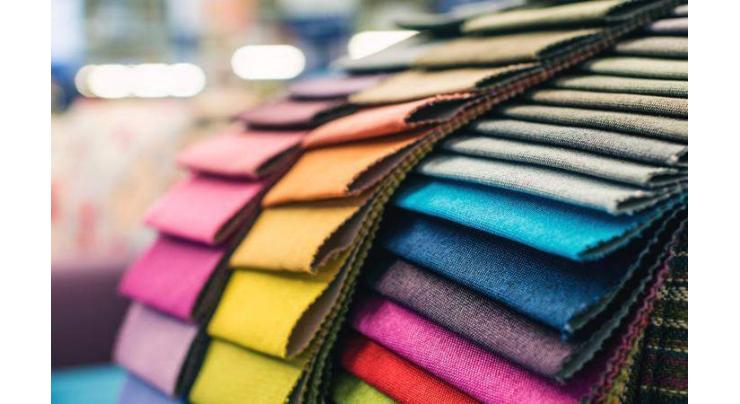
Textile Industry Backbone Of National Economy, Provides Extensive Job Opportunities
Fahad Shabbir (@FahadShabbir) Published November 27, 2020 | 12:17 PM

Textile industry emerged as a major part of the industrialization process in Pakistan during the 1960s and there are about 1200 ginning factories in the country till date including 250 factories in Sindh and more than 720 factories in Punjab while remaining are running in other parts of the country
FAISALABAD, (UrduPoint / Pakistan Point News - 27th Nov, 2020 ) :Textile industry emerged as a major part of the industrialization process in Pakistan during the 1960s and there are about 1200 ginning factories in the country till date including 250 factories in Sindh and more than 720 factories in Punjab while remaining are running in other parts of the country.
According to textile experts, Pakistan is the 4th largest cotton producer and consumer country.
It is among major textile manufacturing countries because it attained 8th position as exporter of textile products in Asia.
Although Pakistan is an agrarian country, its textile industry is considered as the backbone of the national economy because this sector is not only contributing 8.5% share in GDP�but also providing job opportunities to 40 percent of total labor force.
� The Textile industry of Pakistan is also producing artificial silk which resembles silk but costs less to produce and about 90,000 looms are working on this product across the country. According to experts, Pakistan is producing high quality fabric as compared to the fabric produced in other countries.
The Textile industry has an irresistible impact on the national economy and it is contributing 60 percent share in exports of Pakistan. Its textile units are working mainly in Karachi, Faisalabad, Gujranwala and Sialkot while its products are ranked as 3rd in the world.
Spokesman of National Textile University Faisalabad (NTUF) Parvaiz Akhtar said that 511 spinning mills are working across the country mainly in Punjab and Sindh with a capacity of 13.40 million spindles and 199,000 rotors.
This industry is mainly focusing on spinning of coarse and medium fineness yarns.
Total raw cotton consumption of this industry is about 1.1 million bales while the installed capacity was 13.414 million spindles and 187,259 rotors in 2015-16, 1.414 million spindles and 198,801 rotors in 2016-17, 13.410 million spindles and 198,801 rotors in 2017-18 and 13.409 million spindles and 198,801 rotors in 2018-19. These spinning units produced 3397.3 million kilograms yarn in 2015-16, 3428.1 million kg yarn in 2016-17, 3430.1 million kg yarn in 2017-18 and 3431.2 million kg yarn in 2018-19.
He further said that the weaving sector is divided into two sub-sectors including organized mills and unorganized mills but looms of both sectors have lack of capacity to convert whole yarn produced in spinning mills into fiber/cloth. The weaving sector is dominated by a large unorganized sector which roughly accounts for 90% of total weaving capacity. However, power looms have the largest share of output in cloth making.
There were a total 411,688 looms in the weaving sector in 2015-2016 including 375,000 power looms, 28,500 shuttle-less looms and 8188 looms in the mill sector.
Similarly total 412,584 looms were in 2016-17 including 375,000 power looms, 28,500 shuttle-less looms and 9084 looms in the mill sector.
Later this figure remained the same during fiscal years 2017-18 and 2018-19.
Total cloth production of the weaving sector was 9159.2 million square meters in 2015-16 and 9169.7 million square meters in 2016-17 followed by 9170.9 million square meters in 2017-18 and 9147.8 million square meters in 2018-19.
There are about 106 finishing units in the organized sector and 625 units in the small scale sector with a total finishing capacity of 4 billion square meters. Similarly, 12,000 machines are working in the knitwear sector while 5000 apparel units and 700,000 stitching machines are working in the garment sector, he added.
� �A Major item of the textile industry is synthetic fibers and it is also dominating in the market after being prepared with nylon, polyester, acrylic, and polyolefin.
Three types of filament yarn are also produced in Pakistan.
These are acetate rayon yarn, polyester filament yarn, and nylon filament yarn.
Wool-made products of the textile industry including woolen yarn, acrylic yarn, fabrics, shawls, blankets and carpets are also very famous in the market.
However, there is a dire need of up-gradation of the textile sector to improve and increase its productivity by transforming it on value addition.
For this purpose, formulation of new strategies and programs are also imperative to enable this sector to face future challenges and compete in global markets with rival countries.
Textile industry in Pakistan is facing severe setback due to various contemporary problems like COVID-19, reduction in cotton production, shortage of raw material, non-availability of uninterrupted power supply, increase in power tariff, high cost of doing business and environmental hazards, yet its future is very bright if associated with value addition completely by adopting scientific lines including nanotechnology, etc.
According to experts, the Pakistani scientists have attained the position to develop such cloth that cannot get dirty with dust or wet with water.
Similarly, the Pakistani scientists of textile sector can also develop such cloth which can help in beefing up security in case of war.
The major industrial groups have installed state-of-the-art units and are producing world class items which are supplied to global markets. However, the SME sector is needed to be grown on modern scientific lines. 90% units of textile industries belong to the SME sector but this sector is facing lack of Research & Development (R&D) facilities and other contemporary problems.
These problems are increasing cost of products and cost of doing business while the rival regional countries like India and Bangladesh are producing cheap products.
Therefore, tough competition in international markets is also hampering the growth of the textile industry in Pakistan.
On the other hand, the unwillingness of small unit owners to innovate is also a great tragedy for the textile industry. Faisalabad is known as the Manchester of Pakistan's textile industry and the National Textile University is also established here.
Experts keep introducing new ideas and products for the textile industry. But unfortunately, the industrialists of Faisalabad are not showing much interest in adopting new ideas. On the contrary, it would not be out of place to say that the diverse ideas of National Textile University Faisalabad have been adopted more by the industrialists of Sialkot than by the industrialists of Faisalabad and on this basis they have succeeded in introducing new products in the market.
However, the present government has taken various steps for revival of economic activities in the country which may help not only survival but also flourishing of the textile industry.
Industrial cities will help promote activities of the textile industry.
Similarly, establishment of garment cities in Faisalabad, Lahore and Karachi will also play a dynamic role in survival of the textile industry.
CPEC (China Pakistan Economic Corridor) project will also� prove a ray of bright future for textile industry because quick shifting of consignments and their in-time delivery to the buyers in global markets will not only generate maximum foreign exchange for the country but also help in expediting activities of this sector and creating a large number job opportunities for the unemployed persons of Pakistan.
The Government announced to establish 9 Special Economic Zones across the country and these zones will also help in boosting activities of the textile sector. In this connection, first SEZ was established in Faisalabad in Allama Iqbal Industry City while remaining SEZs will be at Rashakai Economic Zone (M-1) Nowshera, Dhabeji Special Economic Zone, Bostan Industrial Zone, ICT Model Industrial Zone, Islamabad, Industrial Park Pakistan Steel Mills Port Qasim, Mirpur Industrial Zone AJK, Mohmand Marble City, Maqpondass SEZ Gilgit-Baltistan.
President Faisalabad Chamber of Commerce & Industry (FCCI) Engineer Hafiz Ihtasham Javed said that the industrial sector was facing severe energy problems as high rate of power tariff was causing increase in production cost. However, the government announced a cut in electricity rate for industrial and SME sectors which will spur manufacturing activities in the textile industry and enhance the pace of economic development.
He appreciated the industrial friendly steps of PTI government and said that these steps ould also offset ill impacts of coronavirus on the textile sector.� Withdrawal of peak hours and provision of electricity at subsidized rate would also encourage industrialists to give a quantum jump to exportable surplus, he added.
He said that a second wave of corona virus is also looming large in Pakistan and at this critical juncture Prime Minister Imran Khan has taken bold decisions to facilitate the textile sector. "Now our industrialists are in a better position to compete in the international markets as their cost of doing business has been curtailed considerably," he added.
Rana Azhar Waqar Central Chairman All Pakistan Cotton Power Looms Association (APCPLA)�said that textile sector could survive through value addition and lifeline of value addition was yarn but unfortunately Pakistan was facing decrease in cotton production whereas export of yarn has further aggravated the situation.
If the government did not impose a ban on export of yarn on an emergent basis, it may be fatal for the value added textile sector.
He said, "We have not yet completed the cotton chain in value addition in Pakistan.
Therefore, the government should immediately abolish all duties on the import of cotton yarn and polyester yarn so that the value added textile sector could be saved from total collapse, he demanded.
Syed Zia Alamdar Hussain former president Faisalabad Chamber of Commerce & Industry (FCCI) said that farmers preferred cultivation of sugarcane instead of cotton due to which heavy reduction was witnessed in cotton production this year. Similarly severe weather conditions coupled with heavy rains also hampered cotton production and it was a very alarming situation. If the government did not take immediate remedial measures, the textile industry would suffer a colossal loss, he added.
Related Topics
Recent Stories

Rock-solid Ruud racks up season-leading win in Barcelona

At UN, Iran says it will make Israel 'regret' reprisals

G7 hears calls for 'critical' Ukraine aid

EU seeks to leverage might to confront China, US challenge

5 Customs officials martyred as their vehicle ambushed by terrorists in D I Khan

Pak-New Zealand match called off due to rain

NHA restores traffic on roads affected by recent rains in Balochistan

China to fully support Pakistan's efforts against terrorism: Ambassador Jiang

U.S. envoy calls on Foreign Minister Ishaq Dar

Poland arrests man over suspected plan to kill Zelensky

EU wants to ease youth movement to and from UK

Police foils attempt of supply mainpuri raw material
More Stories From Business
-

Pakistan's total liquid foreign reserves reach $ 13.37 billion
6 hours ago -

Stock markets rise as traders consider US rate outlook
7 hours ago -

Business community alarmed by alleged Cigarette tax violations
8 hours ago -

High FED on cigarettes demonstrates positive impact
8 hours ago -

PTCL posts 14 % revenue growth
7 hours ago -

Prudent policies, reforms poised to result in sustainable economic growth: Governor State Bank of Pa ..
8 hours ago
-

ICCI resolute to turn Islamabad an ecofriendly city: Khalid Malik
8 hours ago -

Beijing's GDP up 6 pct in Q1
10 hours ago -

China's Q1 goods, services trade surplus exceeds 60 bln USD
10 hours ago -

Pakistan Stock Exchange (PSX) loses 43 points
10 hours ago -

KP Govt decides to establish Gem Processing & Export Centre
11 hours ago -

Rupee sheds 04 paisa against dollar
11 hours ago

















